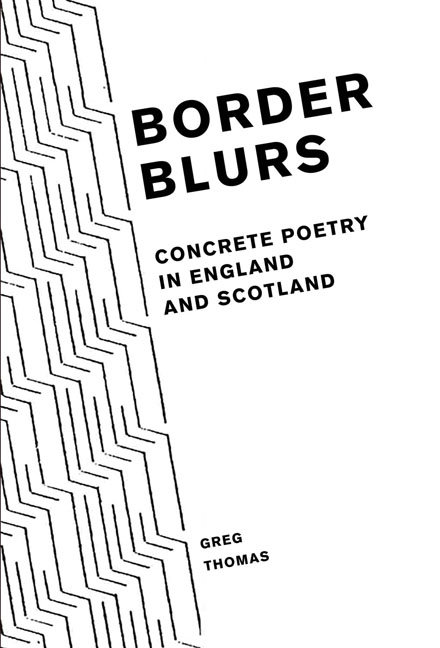Book contents
- Frontmatter
- Contents
- Dedication
- Figures
- Notes on Referencing
- Acknowledgements
- 1 Introduction
- 2 Concrete Poetry/Konkrete Poesie/Poesia Concreta: The International Scene
- 3 Order and Doubt: Ian Hamilton Finlay
- 4 Off-Concrete: Edwin Morgan
- 5 Apophasis: Dom Sylvester Houédard
- 6 Abstract Concrete: Bob Cobbing
- 7 ?Concrete Poetry and After: Conclusion
- Works Cited
- Index
7 - ?Concrete Poetry and After: Conclusion
- Frontmatter
- Contents
- Dedication
- Figures
- Notes on Referencing
- Acknowledgements
- 1 Introduction
- 2 Concrete Poetry/Konkrete Poesie/Poesia Concreta: The International Scene
- 3 Order and Doubt: Ian Hamilton Finlay
- 4 Off-Concrete: Edwin Morgan
- 5 Apophasis: Dom Sylvester Houédard
- 6 Abstract Concrete: Bob Cobbing
- 7 ?Concrete Poetry and After: Conclusion
- Works Cited
- Index
Summary
In Spring 1971 the international exhibition ?Concrete Poetry, which had debuted at the Stedelijk Museum in Amsterdam the previous autumn, was on its way to Britain, with touring legs due at the Walker Art Gallery in Liverpool in October and the Museum of Modern Art in Oxford the following February.1 Bob Cobbing and Hansjörg Mayer, the curators’ contacts in ‘England’ (de Wilde [1970], [15]), had gathered together a wide range of British and Irish work for the Amsterdam show, whose scale and diversity signified both a high-water mark of worldwide responses to concrete poetry and the fact that any clear boundaries once associated with the style had long since been overrun (as that prefixed question mark presumably acknowledged). Writing to Derek Stanford on May 12, Ian Hamilton Finlay described the exhibition as ‘a sorry affair’ whose ‘catalogue re-writes the history of the movement, giving pride of place to the pushers and the manifesto-writers’. ‘A lot of people’, he lamented, ‘seem to have quite forgotten that their first glimpse of concrete poetry was in Poor.Old.Tired.Horse. and not in the publications of Mr. Cobbing or whoever or whoever’ (Finlay 1967–71). Noting Finlay's refusal to contribute to his 1971 concrete poetry anthology Mindplay, John Sharkey paraphrased Finlay's assertions that ‘[h]e feels outside and uninvolved in what is happening now’, and that ‘there are enough anthologies already’ (Sharkey 1971, 16).
Certainly, the style and movement that had seemed to reward his deep-seated impulses towards moral and emotional order when Finlay first encountered them in 1962 would, less than a decade later, have become somewhat unrecognisable to him. Poets for whom the visual and phonetic stylistics of concrete poetry were a means of securing or rationally experimenting with the semantic connotations of language had, in most cases, ceased to practise the style with concerted gusto by the early 1970s. Finlay himself was beginning in earnest to convert the grounds around Stonypath Farmhouse into the neo-classical time capsule of Little Sparta – perhaps the single most striking work of art or literature to emerge from the concrete poetry movement – while Morgan's pluralist imagination had led him into a number of other realms of formal and thematic experiment, with science fiction and sound poetry forming much of the creative nucleus of his 1973 collection From Glasgow to Saturn.
- Type
- Chapter
- Information
- Border BlursConcrete Poetry in England and Scotland, pp. 249 - 260Publisher: Liverpool University PressPrint publication year: 2019



